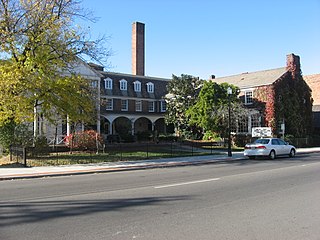
The former Zanesville YWCA, located at 49 North 6th Street in Zanesville, Ohio, United States, is an historic building built in 1926 for members of the Young Women's Christian Association. It was designed by Howell & Thomas. On July 17, 1978, it was added to the National Register of Historic Places. It is now Bryan Place.
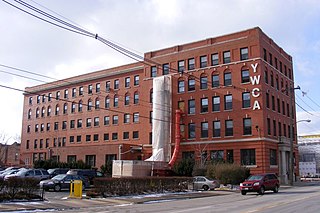
The YWCA Building, located at 25 West Rayen Avenue in Youngstown, Ohio, is an historic building built in 1911 for members of the Young Women's Christian Association. On July 23, 1986, it was added to the National Register of Historic Places. YWCA Mahoning Valley, formerly known as YWCA Youngstown, occupies the building. YWCA Youngstown merged with YWCA Warren on May 1, 2018, to become YWCA Mahoning Valley. YWCA Mahoning Valley also operates a site at 375 North Park Avenue in Warren, Ohio, as well as scattered-site housing in the greater Youngstown area.

The Young Women's Christian Association in Pueblo, Colorado is a historic YWCA building which was built in 1934. It was listed on the National Register of Historic Places in 1980.

The Phyllis Wheatley YWCA is a Young Women's Christian Association building in Washington, D.C., that was designed by architects Shroeder & Parish and was built in 1920. It was listed on the National Register of Historic Places in 1983.

The Lee County Courthouse, also known as the South Lee County Courthouse and the U.S. Post Office and Courthouse, is a historic building located in Keokuk, Iowa, United States.
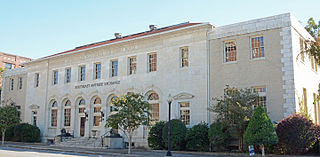
The former U.S. Post Office and Courthouse in Waycross, Georgia was built in 1911 and expanded in 1936. It is occupied in 2016 by the Southeast Antique Exchange business. The building reflects Renaissance architecture and "Romano-Tuscan" architecture. It served historically as a courthouse of the United States District Court for the Southern District of Georgia and as a post office until 1975.

The Keokuk County Courthouse located in Sigourney, Iowa, United States, was built in 1911. It was individually listed on the National Register of Historic Places in 1981 as a part of the County Courthouses in Iowa Thematic Resource. In 1999 it was included as a contributing property in the Public Square Historic District. The courthouse is the fourth building the county has used for court functions and county administration.
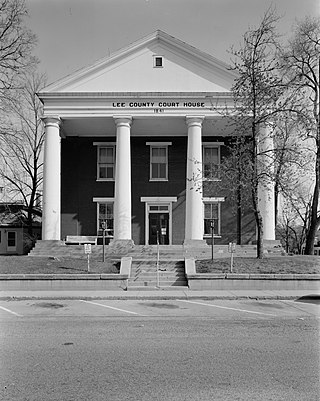
The Lee County Courthouse is located in Fort Madison, Iowa, United States. The courthouse serves the court functions and county administration for the northern part of Lee County, and it is the county's first courthouse. It was listed on the National Register of Historic Places in 1976 as a part of the County Courthouses in Iowa Thematic Resource. In 2014, it was included as a contributing property in the Park-to-Park Residential Historic District. Southern Lee County is served from a courthouse in Keokuk in the former Federal Courthouse building.
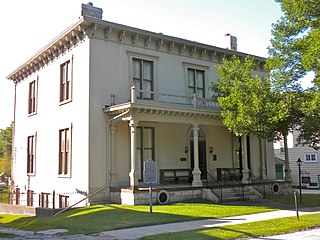
The Justice Samuel Freeman Miller House is a historic building in Keokuk, Iowa, United States. It is now operated as the Miller House Museum by the Lee County Historical Society. The significance of this house is its association with Samuel Freeman Miller who had it built. Originally from Kentucky, he was a physician and a lawyer with a national reputation. Miller was nominated by President Abraham Lincoln to serve on the United States Supreme Court in 1862. His was the first nomination to the court of a person who resided west of the Mississippi River. He served on the court for 28 years. Although he lived here for only two years, Miller always considered this his home.

The C. R. Joy House, also known as The Grande Anne Bed & Breakfast, was a historic building located in Keokuk, Iowa, United States. It was destroyed by fire in July 2018. It was individually listed on the National Register of Historic Places in 1997. In 2002 it was included as a contributing property in The Park Place-Grand Avenue Residential District.

The Sellwood Branch YMCA, also known as the Sellwood Community Center, in southeast Portland in the U.S. state of Oregon, is a 2.5-story structure listed on the National Register of Historic Places. Built in 1910, it was added to the register in 2006.
Shattuck and Hussey was a Chicago-based architectural firm founded by Walter F. Shattuck (1871-1948) and Harry Hussey (1882-1967).
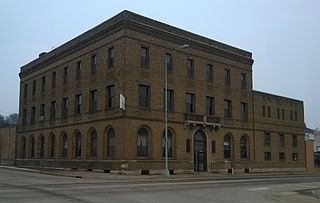
Ottumwa Young Women's Christian Association , also known as Your Family Center, is a historic building located in Ottumwa, Iowa, United States. Its significance is related to the local social movement that provided a safe place to live for young women and education programs that encouraged their business and professional development. The Young Women's Christian Association (YWCA) was established in Ottumwa in 1894 by 64 charter members. They began with opening reading and rest rooms before they opened a boarding house. In 1903 they acquired the former First Baptist Church building for their use. They cooperated with the local Young Men's Christian Association (YMCA) for recreational and camping activities. The YMCA built a new larger facility in 1921 and the YWCA considered buying their old building, but they decided to build their own building instead.
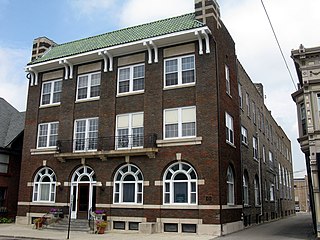
Young Women's Christian Association, also known as the Elkhart Y.W.C.A. and Lexington House, is a historic YWCA located at Elkhart, Elkhart County, Indiana. It was built in 1919, and is a three-story, brick building on a raised basement and Bungalow / American Craftsman style design elements. It measures approximately 40 feet wide and 150 feet deep. It has a flat roof and arched openings on the first floor.

Dubuque YMCA Building, also known as the Iowa Inn, is a historic building located in Dubuque, Iowa, United States. Several area churches partnered to form the local YMCA in 1857. It was one of the first chapters formed west of the Mississippi River. Its activities ceased during the American Civil War, and it was reformed in 1866. They rented rooms on Main Street for their activities. Its first modest gymnasium was outfitted in 1884, and it was improved in 1992 when YMCA took over the facilities over the former Dubuque Athletic Club. The local YMCA completed the first section of this facility two years later, with the second section completed in 1916.

The Young Women's Christian Association is a historic building in Helena, Montana, U.S.. It was built for the local YWCA chapter in 1918, and designed by architect Chester H. Kirk. It has been listed on the National Register of Historic Places since December 27, 1984.

The YWCA of Duluth is a former YWCA building in Duluth, Minnesota, United States. It was designed by architects Frederick German and Anton Werner Lignell and built in 1908 to provide programs and activities for Duluth's young, single women. It contained a gymnasium, swimming pool, cafeteria, meeting rooms, and apartments. In addition to the organization's usual suite of athletics, Bible study, and employment assistance, the YWCA of Duluth catered to the city's large foreign-born population with English and citizenship classes. The building was listed on the National Register of Historic Places in 2011 for its local significance in the theme of social history. It was nominated for its role in local civic development through the YWCA's social welfare efforts.

The Griswold Memorial Young Women's Christian Association, today known as the YWCA Center for Women, is a historic YWCA building in Downtown Columbus, Ohio. It was built in 1929 and was listed on the National Register of Historic Places in 1993. Renovations took place in 1963-64 and 1984. The building was named for Charles C. Griswold, and was a gift of his wife Mary, who donated about $400,000 to the YMCA's building fund.




















